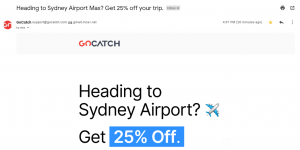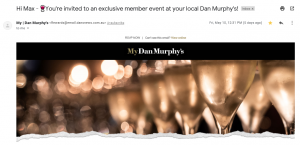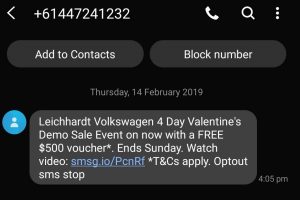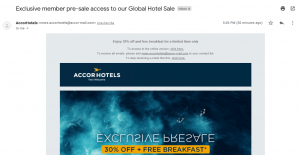It’s tough to cut through all the clutter and noise and make your brand / message stand out. For you marketers out there, I totally get it. However, the one thing that continues to elude many companies and their respective marketing / loyalty teams is that element of relevance.
Relevance is that element that will make the recipient sit up and take notice. The flow on effect will be positive brand engagement and incrementality – which should really be the ultimate goal.
Here are some examples that I’ve received recently.

Actually, no, I’m not heading to Sydney Airport. Not now and not in the near future. There is absolutely no data point that GoCatch holds about me which states that I’m heading to Sydney Airport.
With that single subject header, GoCatch has lost my attention. I’d like to think there was some strategic thinking that’s gone into including me in this list, but the more likely scenario is that they’ve simply emailed everyone in their database hoping for the best; a classic scattergun approach.
An alternative solution:
GoCatch holds multiple important pieces of data about me: I’ve taken one trip in the past, from work to home, I hold 505 GoCoins, which is their loyalty currency and I’ve not used their service in the past 6 months. GoCatch’s primary goal should be to get me to use their service again.
The lowest hanging fruit would be to give me an incentive to put the GoCoins towards another work -> home trip and perhaps even double their value as a discount off the total spend. The result? Likely a lower cost than 25% off as outlined above and significantly more relevant to me, as I travel from work to home on a daily basis.

This communications piece definitely grabbed my attention. Why? Because when filling out my join registration form, I stated that I enjoyed whisky and would love to be invited to exclusive events and tastings. I mean, who wouldn’t, right?
Upon reading further, I discovered a major flaw: this particular event takes place 60kms away from the store that I’d selected as being my local (and which was clearly visible in my member profile). Needless to say, there was significant disappointment when I discovered Dan Murphy’s matched me to the wrong store.
An alternative solution:
If this wasn’t purely a mistake in the data, they should have simply excluded me from the mailing list. From a loyalty member perspective, it’s better not to send correspondence, rather than sending something that is likely to deliver disappointment.

Over the past few months, eBay has been smashing me with emails about anything and everything. This one, in particular, grabbed my attention, because I’ve never drunk Prosecco in my life. It’s absolutely not my favourite liquor and I certainly wouldn’t want it as a special delivery.
This is an example of a subject line which is more appealing than the content.
An alternative solution:
Since registering for my eBay account, I’ve only sold a few items and may have bought a couple of items many years ago. There’s certainly been no proactive engagement with eBay over the past 2 years. This data would be readily available to their marketing team.
I’d suggest they send me an incentive (in the form of an eBay credit) to answer a few quick questions in order to gain a deeper understanding of what I might engage with. Then they could use that data to send me more personalised emails, encouraging me to use the credit and process my first transaction as quickly as possible.

Thank you, Volkswagen, for letting me know about your sale event. I won’t be buying a car however, because I bought a new car from you just over 12 months ago. You have all my details and the date of purchase, and I’m positive you know that most people don’t buy a car every year.
An alternative solution:
Volkswagen should consider implementing a referral program, which could include asking me to share the $500 voucher with family and friends. Should anyone take it up, Volkswagen may also reward me with $500 off my next car purchase, whenever that might be. That would not only be significantly more relevant to me, it would also broaden their reach at no additional cost to them.

Had Accor consulted my member profile, they would have seen that over the past 12 months I had no less than 4 separate bookings at their Sofitel Fairmont Blue Mountains property. As far as a pattern goes, that’s a pretty good one.
The “Global Hotel Sale” did pique my curiosity, so I took a few minutes to check whether the Fairmont was part of it: it was not, so the level of relevancy was marginal, because Accor doesn’t appear to utilise the data they hold on me.
Even if they did have some 3rd party data, they’d realise that I have already booked a trip to Hawaii in December and am staying at a Hilton property, meaning that me taking another international trip is highly unlikely, so the end result should have been to remove me from the mailing list anyway.
An alternative solution:
Accor holds several valuable data points on me: I’m a Silver member, I currently have over 8,500 points and I obviously like to stay at the Fairmont with my wife and 2 kids, in the picturesque Blue Mountains.
One of the things Accor could do is send me a “Pay for 3 nights and stay for 4” type offer, given that I usually only stay for 2 – this achieves higher spend from an existing member.
Another could be to send me snippets of some of their other kid friendly properties around that region, to test whether I’d be open to trialling something different. A variation could include putting the conversion value of my points as a demonstration of what I could be saving.
My tips
- Use the data you have.
- Identify key segments by grouping; most loyalty platforms have this capability.
- Put your customer “relevancy” hat on and ask yourself what sort of communications would be most relevant for each segment.
- Run lots of test and learn campaigns.
Once you’re looking at the data strategically, it shouldn’t take too long for each company’s respective marketing / loyalty teams to come to the same conclusions as I have. Your loyalty program members will reward you with increased engagement, frequency and spend; all it takes is just a little more effort.
Max Savransky is Loyalty Director of Loyalty & Reward Co, a leading loyalty consulting firm based in Sydney. He has 10 years’ experience within the loyalty industry including roles at Mastercard Loyalty (Pinpoint), Silverneedle (Next & Sage Hotels) and Pureprofile. As Loyalty & CRM Manager at HOYTS, he launched the highly successful partnership with Qantas Frequent Flyer, including a world-first Qantas Points in-store redemption proposition. Max consults on program design, commercial modelling and lifecycle strategy, across both traditional and blockchain loyalty projects.
Max is an active cryptocurrency trader and a key contributor to www.blockchainloyalty.io, a global resource centre for everything blockchain loyalty.
Let’s connect!
